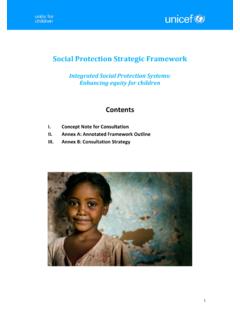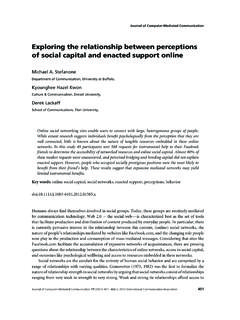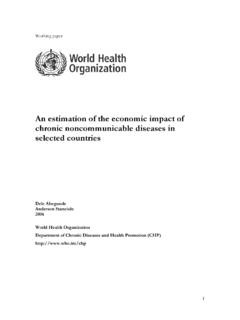Transcription of Indices of Social Development
1 Indices of Social Development Handbook Roberto Foa1 Indices of Social Development , ISS The Hague 2 1 Department of Government, Harvard University, 1737 Cambridge Street, Cambridge, MA 02138, USA. 2 1 Handbook Index of Questions How does what you call Social Development relate to the concept of human Development ? .. 2 How does Social Development relate to basic needs ? .. 3 What are the economic benefits of Social institutions? .. 4 What is the difference between Social institutions and Social capital ? .. 5 How do Social institutions differ from political institutions and governance? .. 5 How can you claim to measure Social institutions?
2 8 How reliable are perceptions-based indicators as measures of Social institutions? .. 9 How can you avoid the perception that the Indices of Social Development , by rating Social institutions, are judging countries based on their culture ? .. 9 Why do you use so many variables rather than selecting one or two key indicators ? .. 9 What does Matching Percentiles mean? .. 10 References .. 12 2 Why are they called Indices of Social Development ? In recent years, there has been a proliferation of attempts to account for the role of Social factors within broader processes of economic and human Development . Whether couched in the language of Social capital, institutions, or culture, economists and Social scientists in related disciplines have made strenuous attempts to quantify the presence of certain informal norms and practices, or institutions, and demonstrate their impact upon the Development process (Putnam 1993, Knack and Keefer 1997, Helliwell 2004).
3 We have opted for the term Social Development as a means of distinguishing our measures as a component within the broader paradigm of human Development , as well as a means of distinguishing our study from related concepts such as political Development , Social cohesion, or Social capital. These differences are explained in more detail below. How does what you call Social Development relate to the concept of human Development ? During the 1990s, the concept of human Development was promoted as a complement to existing income-based approaches to international Development . Rooted in the capabilities literature of Amartya Sen and adopted by the Human Development Reports of the United Nations Development Programme (UNDP), the primary aim of the human Development paradigm was to focus Development thinking more upon the enhancement of people's freedoms, capabilities, and wellbeing.
4 Specifically, the human Development approach sought to achieve three goals: i) to make people the ends and not the means of Development ; ii) to refocus attention on what people can be or do rather than what they can produce; and iii) to ensure that Development policies are aimed at improving people's quality of life, including their health, security, and overall flourishing (Sen 1989). While the theory of human Development has been successful in refining the objectives of Development intervention, however, there has been a running tension between its conceptualization and its measurement (Sen 2003, Fukuda-Parr 2004). As a concept, the theory of human Development proposes a series of general objectives that can encompass all Development aims: ensuring that people are empowered, that people are able to achieve their goals, and that people can live well.
5 As a measurement, however, human Development is typically monitored using the Human Development Index (HDI), which accounts only for levels of income, health and education. Consequently, 'human Development ' is often misconceived narrowly in terms of human capital, that is, the physical and mental properties that people can translate into economic rewards in the marketplace, rather than their overall wellbeing and empowerment (Sen 1997). Within the broad canvas of the human Development concept, however, there remains room for many smaller vignettes, corresponding to the other dimensions along which human flourishing can be attained. The human Development index, as an initial sketch, paints particular emphasis upon individual capabilities such as health or knowledge.
6 Yet as many have remarked, this leaves aside both the 'elementary' prerequisites for human security and survival (absence of poverty, undernourishment, and shelter) and the so-to-speak 'higher' ends such as political rights and freedoms, engagement in a community, and Social cohesion (Trabold-Nubler 1991, Dasgupta and 3 Weale 1992). The authors of the Human Development Reports have attempted to fill in for the missing dimensions by adding measures of human poverty (HPI-1 and HPI-2), gender empowerment (GEM and GDI), and, tentatively, political rights and freedoms. The Social Development concept is a useful vehicle for introducing yet further key dimensions, including civic engagement, inter-group cohesion, interpersonal safety and trust, inclusion of Social and ethnic minorities, gender equity, and strength of families and community ties.
7 How does Social Development relate to basic needs ? If we think about human Development in terms of a series of concentric circles, each corresponding to a sphere within which individuals attain their personal wellbeing, then we are better able to understand how Social Development relates to this broader Development process, according to the various means through which individuals become empowered. This is illustrated in figure The use of concentric circles is not meant to indicate any prioritization or hierarchy of needs , but rather the preconditions for sustainable achievements in each domain. Poverty reduction, for example, is requisite upon giving individuals the knowledge, skills, and human capital that enable investment and growth, but building human capital in an equitable fashion in turn requires institutions that are inclusive of women and minorities, that foster trust and cooperation, and deliver accountability in governance.
8 The first circle then concerns the accumulation of sufficient material resources to alleviate physical hardship, meet basic needs, and address the burden of poverty. Economic Development , or a sustained increase in average incomes, is critical in this process. Early efforts to measure Development progress, including GNI per capita, GDP at purchasing power parity, data on income distribution, poverty, and basic needs, were largely targeted at this level. A second circle surrounds the mechanism via which individuals gain control of their lives, through accumulation of nonmaterial assets, including physical health, education, and skills. The term human capital is often used to capture the individual resources which people may use in order to accomplish a longer and more productive life: when individuals possess knowledge, are physically able, and are well-informed, they stand a better chance of achieving their personal objectives and their personal wellbeing.
9 Measures such as the Physical Quality of Life Index (PQLI) and of course the Human Development Index (HDI) are largely targeted at this level. Finally, there is a third circle concerning how individuals become empowered though the norms, networks, and civic commitments that enable collective action, inclusion, and Social accountability. Specific examples include norms of non-discrimination based on caste, ethnicity, or gender; absence of the frictions between Social and ethnic groups that generate conflict, criminal violence, and insecurity; collective norms of trust and cooperation that ensure efficient provision of public goods; and the informal civic institutions that ensure accountability in local government.
10 Our Indices of Social Development concern this third, institutional aspect of Development . These institutions constitute the enabling environment that allows individuals to translate their economic and human assets (material resources, education and skills) into personal welfare. For example, an individual living in a society characterized by extreme physical insecurity and conflict may find it impossible to start a business or attend college, regardless of their personal initiative, skill, 4 and tenacity. Security and safety, therefore, constitute part of the enabling environment which allows the agent to realize their objectives. What are the economic benefits of Social institutions?




